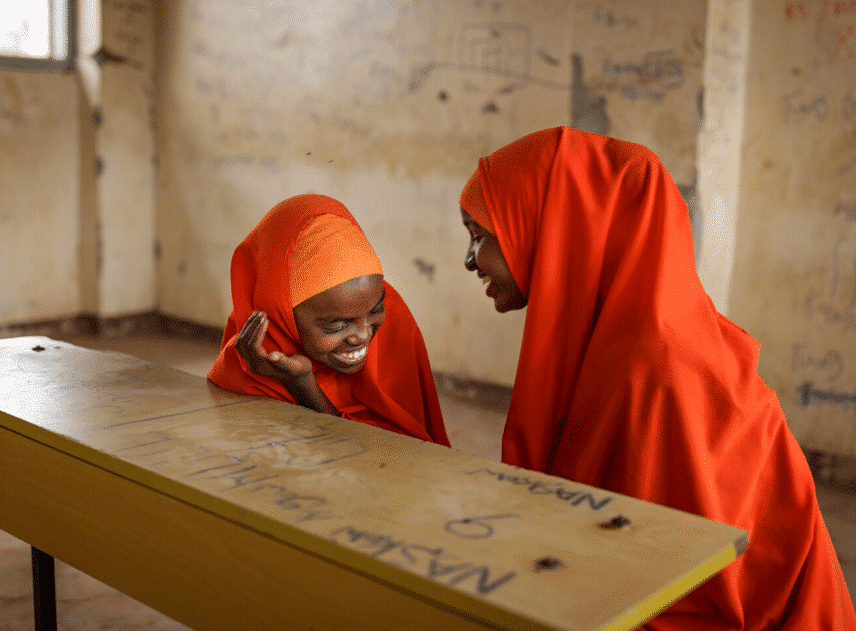
Putting gender equality at the heart of education in emergencies
Introducing the new INEE Guidance Note on Gender
by Nora Fyles & Dean Brooks
This blog post was originally published by the Global Partnership for Education.
As civil war engulfed her home country Somalia, eight-year-old Fatuma fled with her family to Dadaab, Kenya, site of one of the world’s largest refugee camps. With the support of her parents and against all odds, Fatuma excelled in school. Academic excellence earned her a scholarship to an elite boarding school in Nairobi, where at age 15 she was asked by a journalist how she felt as a refugee studying alongside girls from more privileged backgrounds. Her response was striking: “I know where I came from. I know why I’m here.”
A decade later in Toronto, as an alumna of World University Service of Canada (WUSC)’s scholarship program for refugee students, Fatuma launched a petition that helped give rise to the historic 2018 G7 Charlevoix Declaration on the education and empowerment of girls, including in crisis-affected contexts. Encouraged by the advocacy of young people like Fatuma, the Government of Canada made its largest ever single investment in this area.
Recognising education as a critical pathway to gender equality, the Declaration puts education at the heart of humanitarian response as key to redefining gender norms, driving better health and life outcomes, promoting peace and long-term sustainable development. The question is, how can we as a global community harness this growing political momentum to help dismantle the intersecting barriers that threaten to prevent generations of children in fragile and conflict-affected contexts from accessing the education they need?
Evening the odds: from gender parity to equality
In a humanitarian context more than any other, education is a lifeline. Yet, tragically, for millions of children it remains out of reach. For displaced girls especially, education can be protective and empowering. And yet, the odds are stacked against them.
Globally, only 1 in 4 adolescent refugees makes it to secondary school and for every 10 refugee boys enrolled, there are fewer than seven girls. In Dadaab, gender gaps exist at every level, with a mere 7% of girls continuing to secondary education as opposed to 22% boys. At current rates of progress, it is estimated that 1 in 5 girls in crisis-affected contexts will be unable to read a simple sentence by 2030. The world’s children are being failed, with gender-related barriers in education pushing marginalised girls yet further behind.
So, how do we move forward in addressing gender barriers to school enrolment, participation, and progression in humanitarian situations? While accelerated action to advance gender parity is critical, a greater focus on gender equality in and through education is needed to ensure children receive the full benefits of education.
Practical tools for gender-responsive education in emergencies
In response to the need for practical guidance on advancing gender equality in education in emergencies (EiE), the Inter-agency Network for Education in Emergencies (INEE) and UN Girls’ Education Initiative (UNGEI) this year launched the INEE Guidance Note on Gender. Building on the 2010 Pocket Guide to Gender, the Guidance Note has been developed for policymakers, practitioners and everyone involved in EiE as part of emergency preparedness, response or recovery to ensure that programming is gender-responsive by design.
Reflecting the changing nature of crises and shifts in the aid landscape, the Guidance Note features a range of new strategies, tools and approaches for putting gender equality at the heart of EiE. Framed by the INEE Minimum Standards, the featured strategies promote programming that is gender-responsive in terms of participation, coordination and assessment; that advances gender equality in access, teaching practice, curricula and learning; and supports gender-responsive policies, planning and financing. Evidence-based case studies from 14 countries show how these measures can be practically integrated in all aspects of EiE.
Changing the narrative: the Kenya Equity in Education Project
One such case study describes the Kenya Equity in Education Project (KEEP) led by WUSC and funded by the UK Department for International Development’s (DFID) Girls’ Education Challenge. The project focuses on learning outcomes and retention for over 20,000 girls from Dadaab and Kakuma refugee camps and host communities.
A 2013 survey of families in the refugee communities found that only 1.7% considered education to be a valuable investment for girls. By establishing a network of full time community mobilizers, including many former KEEP-supported students, the project tackles gendered barriers, such as domestic chores and early marriage, and builds support for girls’ education and aspirations through engagement with families. Community mobilizers are also trained to work with local male religious and political leaders, encouraging them to champion girls’ education.
In addition, KEEP works with young refugee women such as Fatuma who have pursued higher education in Canada through WUSC’s Student Refugee Program and are willing to return as volunteers to their former country of asylum to share their educational journeys. These powerful young women are a living testimony to what’s possible when girls are given a chance to fulfil their potential through education.
In 2015, KEEP-related research showed a 13% increase in parents who believe in the transformative power of education for girls. The second phase of the project began in 2017, and in 2019 there is a reported a 25% reduction in the proportion of girls who spend a quarter of their day or more doing household chores, and an increase in learning outcomes for literacy (16.1 points) and numeracy (5.3 points) over baseline.
Case studies such as this show how gender-responsive education programming can change the narrative for girls growing up in crisis-affected contexts, strengthening their resilience and potential to rebuild their lives and shape their community. Putting gender at the heart of EiE ensures the best possible prospects for promoting sustainable recovery and gender equality as mutually reinforcing objectives. We hope that the new INEE Guidance Note on Gender will help better equip those at the frontlines of this work to do just that.
Bio: Dean Brooks
Dean Brooks has over two decades of international education experience working in complex emergencies, conflict, disaster and development contexts. Initially, he worked as an international educator (primary, middle-school, and special education). Since 1999, he has focused his work on Education in Emergencies (EiE) and child protection, in a number of settings, including East and West Africa, Eastern Europe, Central Asia, Latin America and the Middle East. Dean has been an active member of INEE since 2001. He is based at the International Rescue Committee in New York, USA.
WUSC works to create a better world for all young people. To learn more, start here or subscribe to get highlights straight to your inbox. Interested in volunteering internationally? View our current opportunities. Looking for a new career opportunity? Check out our current job openings. Or show your support for our cause by making a donation.

